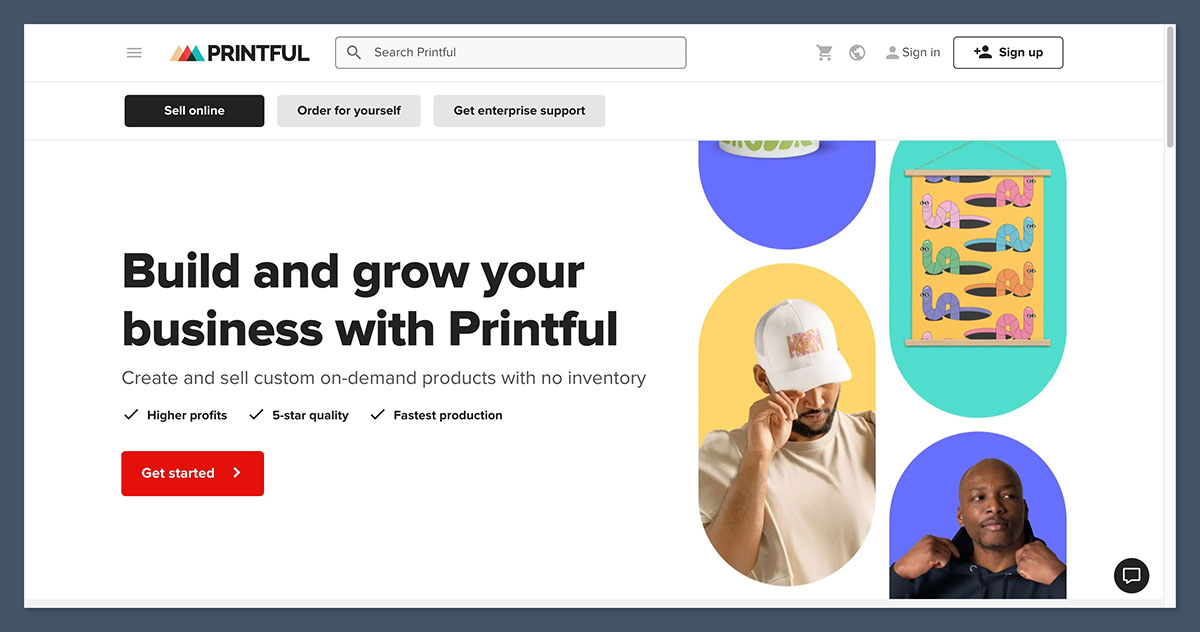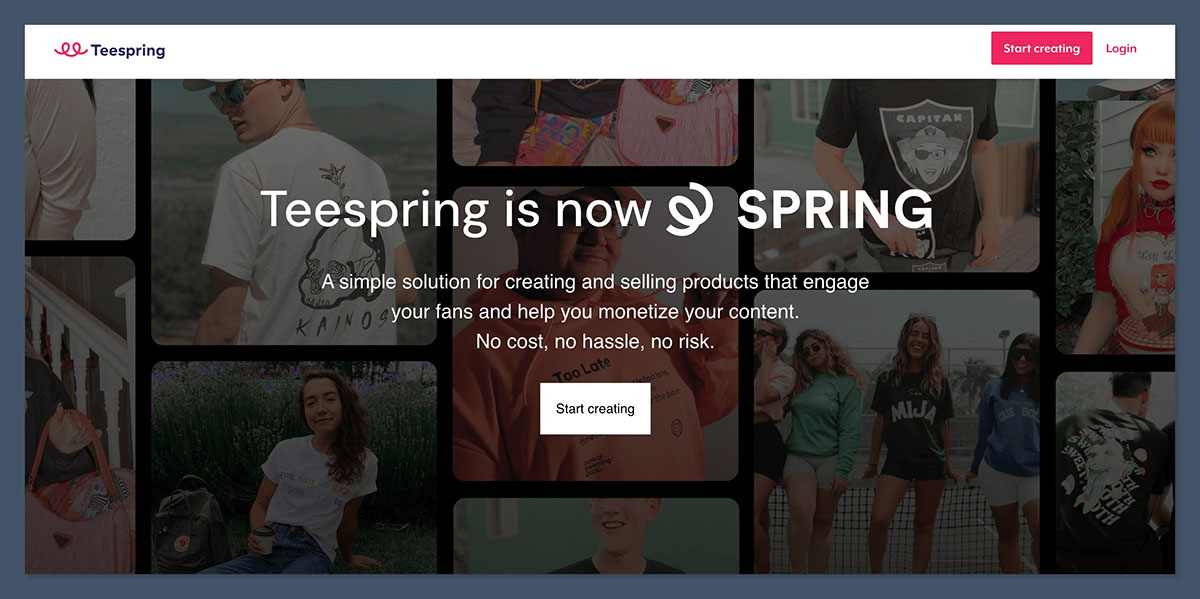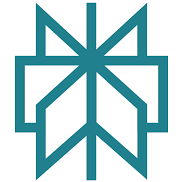Teespring (now rebranded as Spring) and Printful are two major players in the print on demand (POD) space.
They both let you design and sell custom products without holding inventory — but they take very different approaches.
After testing both platforms, I found that Printful is the best choice for building a long-term brand, while Teespring is ideal for quick launches and creators with a built-in audience.
Teespring vs Printful: Quick Verdict
Printful – Best overall, ideal for sellers who want full control over their brand, pricing, and customer data.
Teespring – Best for beginners and creators who want to launch quickly without setting up their own store.
Quick Comparison: Teespring vs Printful
| Feature | Teespring (Spring) | Printful |
|---|---|---|
| Best For | Quick launches, creator merch | Brand-building, scaling an ecommerce store |
| Setup Cost | $0 | $0 (but you need your own store) |
| Product Range | ~60 products | 330+ products |
| Branding Options | Very limited | Extensive (labels, inserts, packing slips) |
| Integrations | YouTube, TikTok, Instagram, Twitch | Shopify, Etsy, WooCommerce, Amazon, etc. |
| Shipping | US/EU focus | Global fulfillment network |
| Traffic Source | Teespring marketplace + social sales | Your own marketing & sales channels |
Best for Pricing: Printful
When it comes to pricing, both platforms have zero upfront cost, but the way you earn money is different.
Teespring sets a base cost for each product. For example:
- Classic unisex T-shirt: $10.57
- Hoodie: $21.99
- Mug: $7.50
You choose the selling price, and the difference is your profit. Sell a hoodie for $39.99 and you’ll keep $18.00 before marketing costs.
Printful also charges a base cost, but because it integrates with your own store, you have more flexibility. Example:
- Bella+Canvas 3001 T-shirt: $12.95
- Hoodie: $25.25
- Mug: $7.95
You can set premium prices if your brand justifies it. A $49.99 hoodie with a $25.25 base cost nets $24.74 profit.
Another important detail is how each platform handles discounts and promotions.
With Printful, you can run store-wide or product-specific sales through your ecommerce platform, giving you room to strategically adjust pricing for events like Black Friday or product launches.
Teespring also allows discounts, but the control is limited compared to having your own store backend. This can impact your ability to use pricing as a marketing tool.
The Winner
Printful offers better long-term earning potential because you control pricing, shipping fees, and upsells.
Best for Product Range: Printful

If variety is important, Printful wins by a wide margin.
Teespring offers around 60 products, mostly in apparel, accessories, and home decor. The focus is on popular merch items like T-shirts, hoodies, mugs, and stickers.
Printful has over 330 products, including:
- Apparel in multiple styles and cuts
- Hats, beanies, embroidered goods
- Wall art, stationery, and home decor
- Bags, backpacks, and phone cases
- Niche items like swimwear and leggings
They also offer print methods beyond DTG (direct-to-garment), such as embroidery, sublimation, and cut-and-sew manufacturing.
Beyond sheer quantity, Printful’s catalog is also updated regularly with seasonal and trending products.
This gives sellers an advantage in reacting to new market demands, like introducing eco-friendly apparel or limited-edition product drops.
Teespring’s catalog changes less frequently, so sellers may need to work harder to stand out.
The Winner
Printful is better for sellers who want a broad catalog and specialty products.
Best for Branding: Printful
This is where the two platforms are drastically different.
With Teespring, all products are shipped in generic packaging with no way to include your own logo, inserts, or thank-you cards.
You also don’t receive customer emails, which means no direct remarketing.
With Printful, you can:
- Add branded inside or outside labels to apparel
- Include custom packaging inserts or stickers
- Print branded packing slips with your logo
- Collect all customer data through your own store
If you want repeat customers and a recognizable brand, this is a must-have.
Branding isn’t just about the product—it’s about the unboxing experience and the emotional connection it creates.
With Printful’s customization options, you can create packaging that feels personal and premium, encouraging customers to share their purchases on social media.
Teespring’s generic packaging makes it harder to build that emotional brand loyalty.
The Winner
Printful, without question. The branding options make it a far better choice for long-term brand building.
Best for Shipping: Printful
Teespring fulfillment:
- US: 5–9 business days
- EU: 7–14 business days
- International: Slower and more expensive
Printful fulfillment:
- US: 2–5 business days
- EU: 2–7 business days
- Ships from 15 fulfillment centers worldwide, meaning faster delivery in more regions
In my experience, Printful’s international delivery is significantly faster because of its network.
Shipping speed directly impacts customer satisfaction and repeat purchase rates.
Printful’s multiple fulfillment centers mean orders are routed to the location closest to the customer, reducing not just delivery time but also shipping costs.
Teespring’s limited production locations can lead to delays and higher international shipping rates, which may discourage global customers.
The Winner
Printful has better global reach and faster fulfillment.
Best for Ease of Use: Teespring

Setting up with Teespring is as simple as creating an account, uploading designs, and publishing to their marketplace. You don’t need to connect to a store, choose payment processors, or deal with integrations.
Printful requires more setup because you need an ecommerce store (Shopify, Etsy, etc.) and you’re responsible for driving traffic. This makes it more flexible, but also more complex for beginners.
Ease of use also extends to managing orders and products.
Teespring’s dashboard is simplified for quick edits and campaign launches, making it ideal for creators who want to focus purely on design.
Printful’s dashboard offers more advanced features and analytics, but that comes with a steeper learning curve.
The Winner
Teespring is easier for complete beginners.
Best for Marketing Potential: Printful
Teespring gives you access to its marketplace audience and integrates directly with YouTube Merch Shelf, TikTok Shopping, Instagram Shopping, and Twitch Merch.
That’s great if you already have an audience or can get your products seen on the platform.
Printful relies on you to market your own store, but this also means:
- You control your SEO strategy
- You can run paid ads on Google, Facebook, TikTok, and Instagram
- You can build an email list and retarget customers
Long-term, this is much more powerful than relying on someone else’s marketplace traffic.
Another big factor is flexibility in marketing channels.
With Printful, you’re not limited by a single platform’s rules or algorithms. You can diversify your marketing strategy across multiple sales channels, run promotions, and create multi-platform campaigns that build your brand outside of a single marketplace.
Teespring’s model is more passive, which works for short bursts of sales but not as well for consistent growth.
The Winner
Printful offers better growth potential because you own the marketing channels and customer relationships.
Best for Support: Tie
Teespring
- Email support
- Help center with guides
- No live chat or phone support for all sellers
Printful
- 24/7 live chat support
- Email support
- Detailed help articles and tutorials
The quality of support can make a difference when dealing with time-sensitive order issues.
While Teespring’s email support is fine for general questions, Printful’s live chat can be a lifesaver for resolving urgent problems like shipping delays or order errors.
That said, both platforms offer searchable help centers that can answer most beginner questions without needing to contact support.
The Winner
Printful edges out slightly with live chat availability, but Teespring’s help center is still solid.
Case Studies and Seller Examples
Teespring Success Story
One YouTuber earned over $20,000 in a single month from viral merch sales on Teespring, purely through their channel audience.
This worked because Teespring integrated directly with YouTube, so fans could buy without leaving the platform.
What made this campaign successful was the creator’s ability to design products that resonated directly with their audience’s in-jokes and culture.
Because Teespring handled all fulfillment and customer service, the creator could focus entirely on producing content and promoting the merch in videos, which drove sustained sales over several weeks.
Printful Success Story
An independent streetwear brand used Printful with Shopify, built an email list of 15,000 customers, and scaled to $250,000 annual revenue within two years.
They credited the success to custom packaging, premium pricing, and social media ads.
This brand also leveraged Printful’s integrations with multiple platforms, allowing them to sell on Instagram, TikTok, and Etsy simultaneously.
By running targeted ads and retargeting past customers via email, they were able to maintain a steady growth curve rather than relying on seasonal spikes.
The ability to control branding and own the customer relationship was key to their repeat purchase rate.
Our Verdict
If you want speed and simplicity, Teespring is the easier choice. It’s great for creators who want to launch merch quickly and tap into built-in marketplace traffic without setting up their own store.
If you want full control, branding options, and the ability to scale a real ecommerce business, Printful is the better long-term investment. It requires more effort upfront, but you own the customer relationship and can build a brand that lasts.
In some cases, using both can be strategic — Teespring for quick trend-based campaigns and Printful for building your core brand store.
Teespring vs Printful: Pros and Cons
| Platform | Pros | Cons |
|---|---|---|
| Teespring | Free to start, no tech setup, built-in marketplace traffic | Limited branding, smaller product range, no customer data |
| Printful | Full brand control, huge product range, faster shipping | Requires own store, needs marketing effort |
Both platforms can be profitable, but they serve different goals.
Teespring is best for quick launches and creators with built-in audiences, while Printful is ideal for sellers focused on long-term brand growth.
Your choice should align with your business strategy, resources, and the level of control you want over your products and customers.






